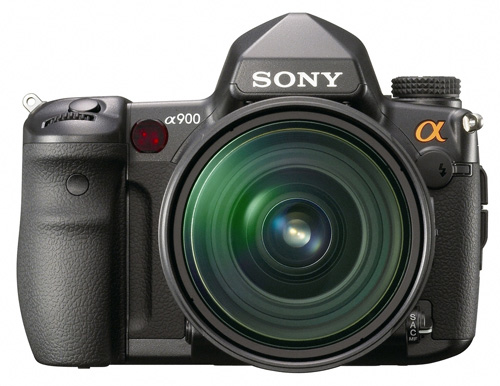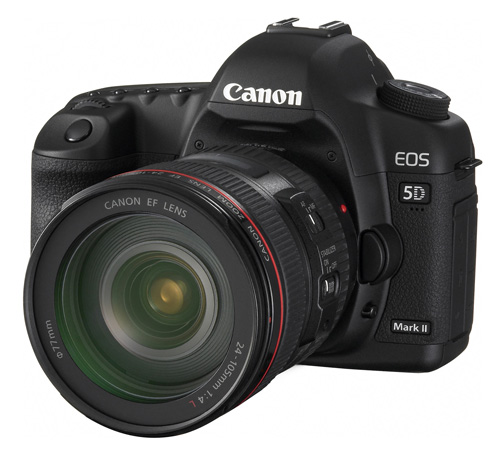Photokina 2008: Full-Frame and Megapixels Rule
by Wesley Fink on September 26, 2008 2:00 AM EST- Posted in
- Digital Camera
Full-Frame Takes Over the High-End
Almost two years ago, in our year-end DSLR Buying Guide, we talked about the likelihood that full-frame would take over the pro and high-end of the DSLR market. Frankly, it has happened even faster that we imagined. If there was any doubt that the full-frame sensor would rule the high-end it has been laid to rest at Photokina 2008.
Sony likes to point out in presentations that they are now the clear number three in the camera market. That certainly has been confirmed recently by Mizuho Securities Equity Research in Tokyo, who found Sony has a 12% share of the DSLR market in the second quarter of 2008. This is more than double the Olympus market share. Sony has made great strides since acquiring Minolta, but it is still a long way to the 40%+ Canon DSLR market share in the same second quarter or the 30% Nikon share reported by Mizuho. Interesting enough, the Sony DSLR market share in some European markets is approaching 25%, or roughly double the US share.
Perhaps most interesting from the Mizuho data is the high cost Sony is paying to earn that market share. In the period from April to June 2008:
| DSLR Operating Profit Margin | ||
| Company | DSLR Shipments | Operating Profit Margin |
| Canon | 1050000 | 23.20% |
| Nikon | 820000 | 19.10% |
| Sony | 330000 | -16.70% |
| Olympus | 150000 | -6.70% |
The report grouped all other cameras in the "Other" category and did not break out data for Pentax for example. Sony has deep pockets, but as a corporation we have to wonder how long Sony will tolerate this "bleeding" in their quest to win DSLR market share. To Sony's credit, they stuck with their plan and forged ahead to offer a "pro-friendly" full-frame Sony DSLR.

The $3000 Sony A900 was launched at Photokina with the clear goal of demonstrating Sony's prowess in the digital sensor market. It is no real secret that Sony produces digital sensors for most other DSLRs in addition to their own brand. The quest to top the resolution chart is closely tied to Sony's desire to drive that point home to the market.
Sony does not appear to have addressed the high ISO sensitivity in the same manner as the most recent Canon and Nikon full-frame cameras, but a full test when the A900 ships will shed more light on this question. For now, the Sony remains the only full-frame DSLR with body-integrated Image Stabilization (IS) that will work with any lens that can mount on the camera.

The Canon 5D is the camera that launched the "semi-pro" full-frame DSLR market, although many will wonder how a camera that originally sold for $3500 targeted "advanced amateurs". However, the 5D is now almost 3 years old. The replacement for the 5D has been "missing in action" for so long that many wondered if Canon had any plans to update a camera that was losing its competitive edge. The answer was cleverly hyped and announced just before the start of Photokina 2008, with the long-expected moniker of Canon 5D Mark II. While industry observers expected an increase in resolution, most did not expect Canon to move all the way to 21.1MP. This is the same resolution as the $8000 Canon 1Ds Mark III, but the 5D sensor is even better. It has ISO options to 25600 - providing both amazing resolution with amazing low-light sensitivity if it performs as promised.
With the big three - Canon, Nikon, and Sony - all now having at least one full-frame model at the top, it should now be clear that the high-end and pro markets have completely shifted to the full-frame sensor with no lens factor for the lenses. As predicted two years ago, the APS-C sensors will now be for entry and midrange cameras in the DSLR market. That, of course, means that all the lens manufacturers will be forced to produce better full-frame lenses with better resolution - or fall by the wayside as full-frame takes the high-end market.
To put in perspective where full-frame can go and what it can do, just look at the charts on page two. The highest resolution full-frame (Sony A900) is still lower pixel density, at 2.9MP per square centimeter, than any current APS-C DSLR. In fact if today'sMP leader in APS-C cameras (Panasonic G1) were to use the same pixel density in a full-frame sensor, that resolution would be 43MP. In more familiar terms, if the resolution of the new Canon 50D were to be carried over to full-frame that sensor would be 38.8MP. The point: full-frame sensors will definitely feature even higher resolutions, with every expectation of good high-ISO performance.










16 Comments
View All Comments
plonk420 - Saturday, September 27, 2008 - link
one person i know says that this is a breakthru for indy film producers. another person in film doesn't believe that it's coming from a digiSLR...http://vincentlaforet.com/">http://vincentlaforet.com/
a short film produced WITHOUT POST PRODUCTION (save for resizing) with the 5D Mark II as source. impromptu petition has even been setup to try to convince Canon to bequeath it with 24p in a firmware update...
yyrkoon - Saturday, September 27, 2008 - link
Being the leader in image manipulation, I am surprised that Adobe gave no details as to what CS4 is capable of ? This is an assumption on my behalf because I am sure you guys at Anandtech.com *would* report the nitty-gritty if it were made available . . . right ?It is rumored that CS4 will take advantage of CUDA for parallel processing of images. This could be a HUGE boon for image retouchers, and judging from the current CUDA enabled scripting filter examples on Adobes site, I would view this as the next logical step for them.
Wesley Fink - Saturday, September 27, 2008 - link
The info provided by Adobe was short on specifics and big on sweeping generalities in the Press release. Adobe does claim more support of current hardware and is said to fully support quad core processing. That should interest our readers. CS4 also claims to better support today's graphics cards (GPU) for smoother pan and zoom functions though they don't specify which GPU hardware they are talking about.To be blunt most PS users are forced to upgrade because Adobe makes new versions of its very popular Camera RAW plug-in incompatible with older PS versions. That means when you finally get your newer camera you are forced to upgrade PS if you want to process RAW files in Photoshop.
We believed our readers would want to know a new version of Photoshop is coming, and they could find out more it they were interested. You can see the Press Release for yourself at http://www.adobe.com/aboutadobe/pressroom/pressrel...">http://www.adobe.com/aboutadobe/pressro...srelease... We decided not to repeat it. We will know more when Photoshop CS4 and PS CS4 Extended ship next month.
yyrkoon - Saturday, September 27, 2008 - link
Yeah, thats exactly what I did: read adobes support pages, and the list is quite extensive. Albeit not as extensive as I hoped.One thing that Adobe can not do quite right is standardize their UI, which they have changed AGAIN, and honestly it is annoying. They *claim* it will improve the user experience, and help speed things up, but that yet remains to be seen.
melgross - Friday, September 26, 2008 - link
There's an error in the first chart. The Nikon etc. numbers should read 15.7 x 23.5.This also shows why the 4/3 format has such a problem. If Olympus/Panasonic want to make a 15 MP sensor, the pixel density will jump to 6.2. That's way above where the other cameras will be. The 50D, with 15 MP is at 4.5. This will be a disadvantage in S/N. With less pixels, this hasn't been as much of a problem (though Panasonic has always has noise problems), but as site size continues to diminish, they will find it more difficult to make up for it.
Wesley Fink - Friday, September 26, 2008 - link
Dimension is corrected. The area was correct, but the decimal number for one dimension got dropped in editing.melgross - Friday, September 26, 2008 - link
Olympus doesn't use the faster, and often more accurate, phase detection for auto focus?Or is it that the compatibility will only extend to the older method of contrast detection?
If so, and there's no phase detection, that's a negative.
strikeback03 - Monday, September 29, 2008 - link
They do use phase detect in their SLRs, along with some having contrast detect capability. The micro-4/3 cameras, as they have no mirror or other means of redirecting light, cannot use phase detect AF.And I also wonder why anything in the lens has something to do with whether contrast detect AF works or not.
Johnmcl7 - Friday, September 26, 2008 - link
"The prototype has interchangeable Micro Four Thirds lenses and can fit today's Four Thirds lenses with full functionality by using an adapter"As far as I'm aware the G1 does not have full compatibility with 4/3 lenses, there's no AF unless the lens supports contrast detect AF which is expected to be the same for the Olympus micro 4/3. The press release is vague on the point as it simply says you can mnount the lenses.
John
Wesley Fink - Friday, September 26, 2008 - link
You are certainly correct that the Press release is less than crystal clear on this point. Based on the info you provide I have slightly changed the description you quote to remove "with full functionality".We are also dealing with a prototype 6 months from introduction and we can only speculate on the shipping product. If your speculation is correct then four current 4/3 lenses support contrast detect. They are the 14-42mm, 40-150mm, 25mm f2.8, and the latest Panasonic/Leica 14-50mm.
Olympus was able to add contrast-detect compatibility to these lenses with a firmware upgrade. We are left to wonder whether that may be possible with other current 4/3 lenses. We will know with the shipping Olympus Micro 4/3 compact.